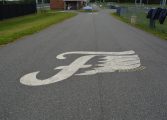My hope is that this year, we will find a lot fewer plants to pull. This is the best time of year to pull it because it hasn’t had a chance to flower yet, or to spread seeds.
Garlic Mustard is an invasive species that can live in shade and will spread through a forest. To quote the Native Plant Society webpage, “Garlic mustard poses a severe threat to native plants and animals in forest communities in much of the eastern and midwestern U.S. Many native widlflowers that complete their life cycles in the springtime (e.g., spring beauty, wild ginger, bloodroot, Dutchman’s breeches, hepatica, toothworts, and trilliums) occur in the same habitat as garlic mustard. Once introduced to an area, garlic mustard outcompetes native plants by aggressively monopolizing light, moisture, nutrients, soil and space. Wildlife species that depend on these early plants for their foliage, pollen, nectar, fruits, seeds and roots, are deprived of these essential food sources when garlic mustard replaces them. Humans are also deprived of the vibrant display of beautiful spring wildflowers.”
Garlic mustard also poses a threat to one of our rare native insects, the West Virginia white butterfly (Pieris virginiensis). Several species of spring wildflowers known as “toothworts” (Dentaria), also in the mustard family, are the primary food source for the caterpillar stage of this butterfly. Invasions of garlic mustard are causing local extirpations of the toothworts, and chemicals in garlic mustard appear to be toxic to the eggs of the butterfly, as evidenced by their failure to hatch when laid on garlic mustard plants.
And we will also be looking for spring flowers and we will talk about why some flowers only bloom in the spring!
Hope to see you at the Heritage Rail Trail on April 13 at 2 p.m. You will find the entrance to it at the little parking lot across from the new county courthouse and office building. Who knows what other treats will be part of our day?
© Fluvanna Review 2022. All rights reserved.
Produced by Valley Publishing Group




